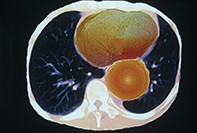Peer Reviewed
GP emergency management
Managing an older man with a thoracic aortic aneurysm
Abstract
Hans is 68 years old and a regular patient of your practice associate who is currently on holiday. Hans comes to see you about two of his toes on his left foot and one on his right foot because they are tender and have a bluish-black area extending over the pulp.
Key Points
- Embolism in the periphery is often tender and peripheral pulses may be normal. The sources of potential emboli should be considered.
- Patients should be referred urgently to a vascular surgeon or hospital if an aortic aneurysm is suspected.
- A family history of an aortic aneurysm is a known risk factor for the first-degree relatives.
- In patients with a known aortic aneurysm, screening is usually performed every six months in the absence of new symptoms.
- Surgery is preferable to observation if the aortic aneurysm is showing signs of complications or if it is greater than 5.5 cm in diameter in men or 5.0 cm in women.
Purchase the PDF version of this article
Already a subscriber? Login here.

